STE Highlights, November 2021
Awards and Recognition
Tretiak receives Humboldt Research Award
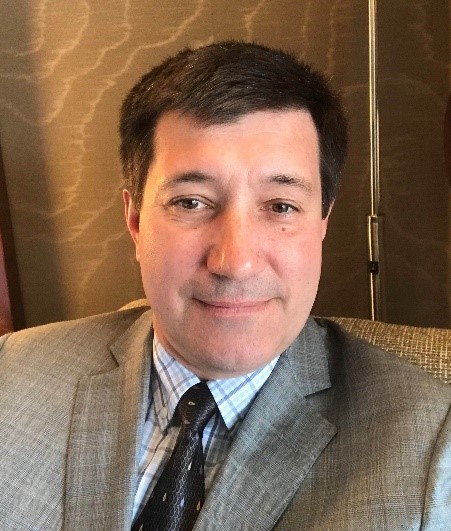
Sergei Tretiak
Los Alamos National Laboratory researcher Sergei Tretiak has been awarded the prestigious Humboldt Research Award by the Alexander von Humboldt Foundation. The Humboldt Research Award honors researchers whose “whose fundamental discoveries, new theories or findings have had a lasting effect on their discipline beyond their immediate research area and who are expected, moreover, to continue producing outstanding research in the future.” The award is one of the most important awards in Germany to foreign scientists aiming to establish collaborations between German scientists and those from other countries.
The award finances extended research visits to Germany. Tretiak is an expert in theoretical chemistry and modeling excited state dynamics in nanoscale materials. He plans to conduct collaborative research at the University of Bremen and the University of Oldenburg (Germany) in the incoming years.
Tretiak is the Physics and Chemistry of Materials (T-1) deputy group leader in the Theoretical Division and a Laboratory Fellow. He received his master’s degree in physics in 1994 from the Moscow Institute of Physics and Technology (Russia) and his doctoral degree in chemistry in 1998 from the University of Rochester. He was a director-funded postdoctoral fellow from 1999 to 2001, and subsequently became a staff scientist at the Laboratory and a member of the Center for Integrated Nanotechnologies.
Tretiak’s research interests include development of electronic structure methods for molecular optical properties, nonlinear optical response, non-adiabatic dynamics of electronically excited states, optical response of confined excitons in conjugated polymers, carbon nanotubes, semiconductor nanoparticles, mixed halide perovskites and molecular aggregates, as well as the use of machine learning and data science toward modeling electronic and chemical properties. Tretiak has published more than 300 scientific publications cited more than 21,000 times (h-index=70) and he has presented more than 300 invited and keynote talks in the U.S. and abroad. Tretiak is an American Physical Society Fellow and a Fellow of the Royal Society of Chemistry. He has also received the Los Alamos Postdoctoral Distinguished Mentor Award and the Los Alamos Fellows’ Research Prize.
The Alexander von Humboldt Foundation honors the legacy of Alexander von Humboldt (1769-1859), a nature researcher and explorer, scientist, and patron. The German government created the Humboldt Foundation to promote international cooperation between German institutes of higher learning and those in other countries. Every year, the Alexander von Humboldt Foundation grants up to 100 Humboldt Research Awards to internationally leading researchers of all disciplines from abroad in recognition of their academic record to date. The Foundation maintains a network of more than 30,000 Humboldtians from all disciplines in over 140 countries worldwide, including 57 Nobel laureates.
Prasankumar named Fellow with Optica

Rohit Prasankumar
Rohit Prasankumar, technical staff member and Thrust Co-Leader for Nanophotonics and Optical Materials with the Center for Integrated Nanotechnologies (CINT), has been named a Fellow with Optica. The Fellow rank is earned through “distinction in the advancement of optics and photonics through distinguished contributions to education, research, engineering, business, and society,” according to Optica. The number of Fellows each year is limited to less than 0.5 percent of OSA’s current membership.
Prasankumar’s election recognizes his expertise in understanding ultrafast phenomena in quantum materials, including superconductors, multiferroics, and topological materials. At CINT Prasankumar has developed several techniques for studying materials with high temporal and spatial resolution over a broad spectral range. He has co-authored 75 papers, including publications in Nature Materials, Nature Communications, Physical Review Letters and Nano Letters. He has also published three book chapters and co-edited the book Optical Techniques for Solid-State Materials Characterization.
Prasankumar received a bachelor’s degree in electrical engineering from the University of Texas in 1997 and master’s and doctoral degrees in electrical engineering from the Massachusetts Institute of Technology in 1999 and 2003, respectively. Prasankumar subsequently performed his postdoctoral research at Los Alamos, focusing on ultrafast mid-to-far-infrared dynamics in semiconductor nanostructures and strongly correlated compounds, before joining CINT in 2006. In 2018 Prasankumar became the Thrust Co-Leader for Nanophotonics and Optical Nanomaterials at CINT. He is also a research associate professor at the University of New Mexico.
Prasankumar joins 2,800 members who have earned the rank of Fellow since 1959 with Optica. Optica, formerly OSA, has worked to advance optics and photonics worldwide since 1916. Optica currently services 432,000 customers, 22,000 individual members, and 290 corporate members from more than 180 countries.Clean Chemistry Team achieves ISO 17025 accreditation
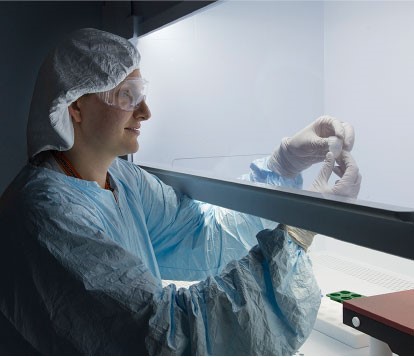
Los Alamos technologist Allison Wende examines a sample in a Laboratory clean room.
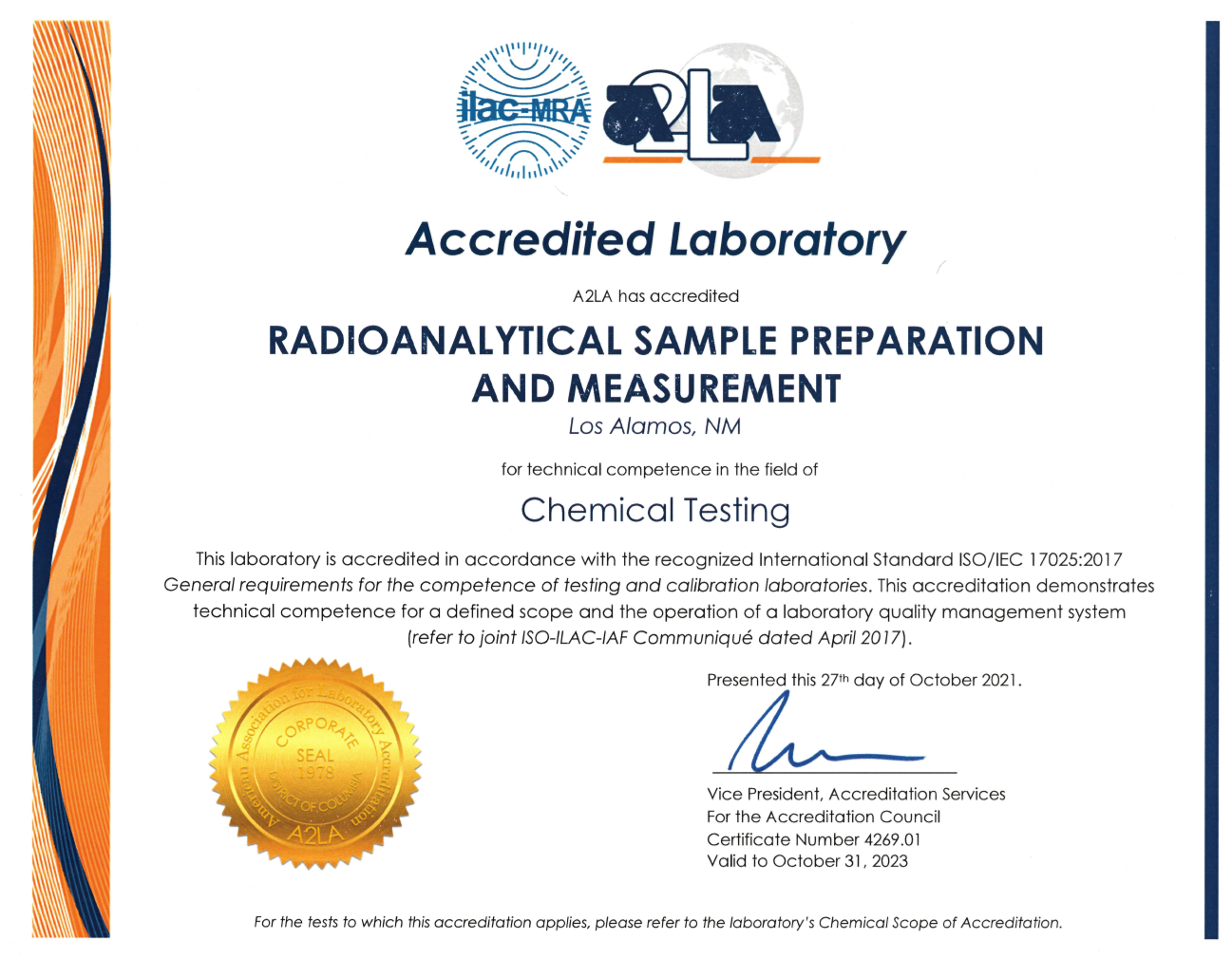
The accreditation is valid through October 2023.
The Clean Chemistry Team in the Nuclear and Radiochemistry (C-NR) group has achieved ISO/IEC 17025 accreditation, developed by the International Organization for Standardization (ISO) and International Electrochemical Commission (IEC) and awarded by the American Association for Laboratory Accreditation. This accreditation demonstrates that the team can generate accurate and defensible results in pursuit of its mission. Valid through 2023 for radioanalytical sample preparation and measurement, ISO/IEC 17025 accreditation covers “general requirements for the competence of testing and calibration laboratories.”
The Clean Chemistry Team manages expertise and capabilities for the ultra-low-level radionuclide analysis in environmental samples for bioassay, nonproliferation, nuclear forensics and nuclear security programs. Analytical platforms maintained by the team include multicollector thermal ionization mass spectrometry, inductively coupled plasma mass spectrometry (multicollector and single collector), large geometry secondary ion mass spectrometry, and scanning electron microscopy. The team participates in national and international nuclear forensics exercises, performs routine measurements for actinide bioassay programs and maintains broad low-level actinide analysis capabilities.
The ISO is an independent, non-governmental organization with a membership of 162 national standards bodies. It develops voluntary, consensus-based, market-relevant international standards. Developed by laboratory experts and organizations from around the world for the organization, ISO/IEC 17025 is applied for by testing and calibration laboratories that wish to demonstrate their capacity to deliver reliable results.Chemistry
Computing molecular excited states on a D-Wave quantum annealer
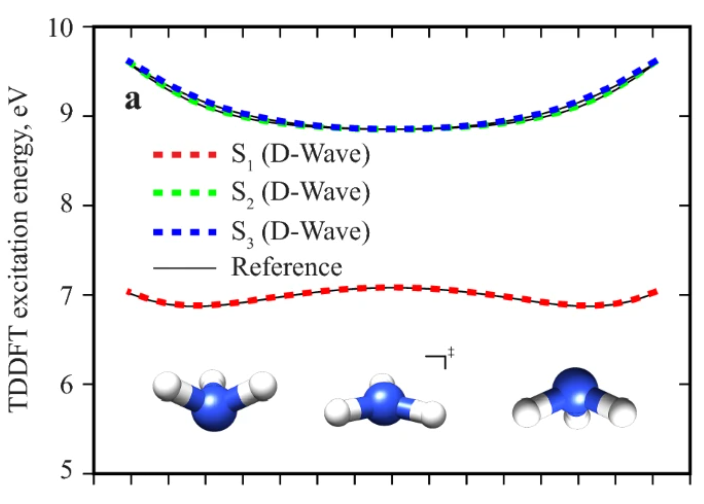
Excitation energies for the singlet of ammonia (NH3). The first three excitation energies are computed using the QAE and D-Wave 2000Q quantum annealer (dashed red, green and blue curves). The reference calculation is shown for comparison (thin black curves).
In work recently published in Scientific Reports (a Nature journal), Los Alamos scientists demonstrated the possibility of using quantum annealers to calculate the excited electronic states of molecular systems. The use of a D-Wave quantum annealer to calculate excited states shows great promise, and the range of applications that would benefit from the calculation includes photovoltaics, lighting, photocatalysis, semiconductors, molecular chromophores, carbon nanotubes and more.
Quantum annealing is a key problem-solving concept in quantum computing. Theoretical and computational chemists have been calculating the electronic ground states of a molecules for decades; however, the calculation of excited states has been a challenge that if solved opens up many possibilities.
The D-Wave quantum annealer is a prototype adiabatic quantum computer that can be used to solve combinatorial optimization problems, and its potential is still being explored. The researchers used the Los Alamos D-Wave quantum annealer to calculate the excited electronic states of molecular systems using two methods: time-dependent Hartree–Fock and time-dependent density-functional theory, both within a Tamm–Dancoff approximation (TDA). The resulting TDA eigenvalue equations were solved on a D-Wave quantum annealer using the Quantum Annealer Eigensolver, also developed at Los Alamos.
A key result was the demonstration of the convergence of excitation energy with basis set for a hydrogen molecule. They also calculated excitation energies for a number of other small molecules and evaluated other properties such as transition dipole moments and oscillator strengths.
Funding and Mission
Funding for this work was provided by Laboratory Directed Research and Development. The work supports the Laboratory’s Energy Security mission area and the Information Science and Technology and Materials for the Future capability pillars.
Reference
“Computing molecular excited states on a D-Wave quantum annealer,” Scientific Reports, 11, 18796 (2021); https://doi.org/10.1038/s41598-021-98331-y. Authors: Alexander Teplukhin, Brian K. Kendrick, Susan M. Mniszewski, Yu Zhang, Ashutosh Kumar, Christian F. A. Negre, Petr M. Anisimov, Sergei Tretiak & Pavel A. Dub.
Technical Contacts: Sergei Tretiak (T-1) and Pavel Dub (C-IIAC)Computer, Computational and Statistical Sciences
Project to develop AI and ML algorithms wins DOE funding

The three-year project focuses on designing neural networks for datasets from high-dimensional dynamic systems and understanding mathematical properties.
A Laboratory-led project is the winner of a $1.2 million Department of Energy (DOE) award for collaborative research projects that develop artificial intelligence and machine learning (ML) algorithms for enabling scientific insights and discoveries from data generated by computational simulations, experiments and observations. This award was part of a $16 million package for five projects for data-intensive scientific machine learning research and analysis. The three-year project, “Inertial neural surrogates for stable dynamical prediction,” led by principal investigators Qi Tang and Joshua Burby of Applied Mathematics and Plasma Physics (T-5), focuses on designing neural networks for datasets from high-dimensional dynamic systems and understanding mathematical properties.
Fusion modeling, led by Los Alamos, and climate modeling, led by research partners at Argonne National Laboratory, will focus on both experimental data and simulation data.
The explosion of data in the digital revolution combined with the machine learning revolution promises many significant potential benefits to DOE missions. These include the discovery of structure and correlations in high-dimensional data as well as the promise of computationally efficient surrogates. For instance, practical particle-in-cell simulations for fusion device modeling typically use billions of particles or more. The particle data is massive, and direct manipulation of the data is computationally expensive, which poses a significant challenge even on exascale platforms.
A plausible solution to those challenges may be to use data-driven reduced order models to build a surrogate for capturing the fundamental physics (in contrast to physics-based reduced models). However, those approaches have limited success in such scenarios, due to the absence of long-time stability. It is commonly found the reduced-order model prediction quickly becomes nonphysical when the dynamics move away from the training data. Therefore, successful deployment of ML-surrogates requires fundamental advances in reliability, robustness, and rigorous theoretical developments for the widespread utilization of modern ML tools, particularly for challenging problems from data-driven approaches of applications adjacent to the DOE mission.
With that motivation, the objective of the project is to introduce a theoretical framework for surrogate modeling of high-dimensional, deterministic, and stochastic dynamical systems on lower-dimensional invariant manifolds. The team will construct the foundations of novel scientific machine learning algorithms that automatically identify and approximate low-dimensional embeddings and deploy stability-preserving surrogate models for dynamical systems on them. The developments of this proposal shall lead to a dramatic improvement in accuracy and times-to-solution for scientific tasks across several domains such as for manifold identification, surrogate-based forecasting, optimization, and sensitivity analyses for high-dimensional data that emerges in areas such as geophysical and fusion data sets.
Mission and Funding
The work is supported by the U.S. Department of Energy Office of Science, Office of Advanced Scientific Computing Research, and supports the Laboratory’s Global Security mission area and its Information, Science and Technology capability pillar.
Technical Contacts: Joshua Burby and Qi Tang
Materials Physics and Applications
Perovskite nanocrystals stabilized in metal organic frameworks
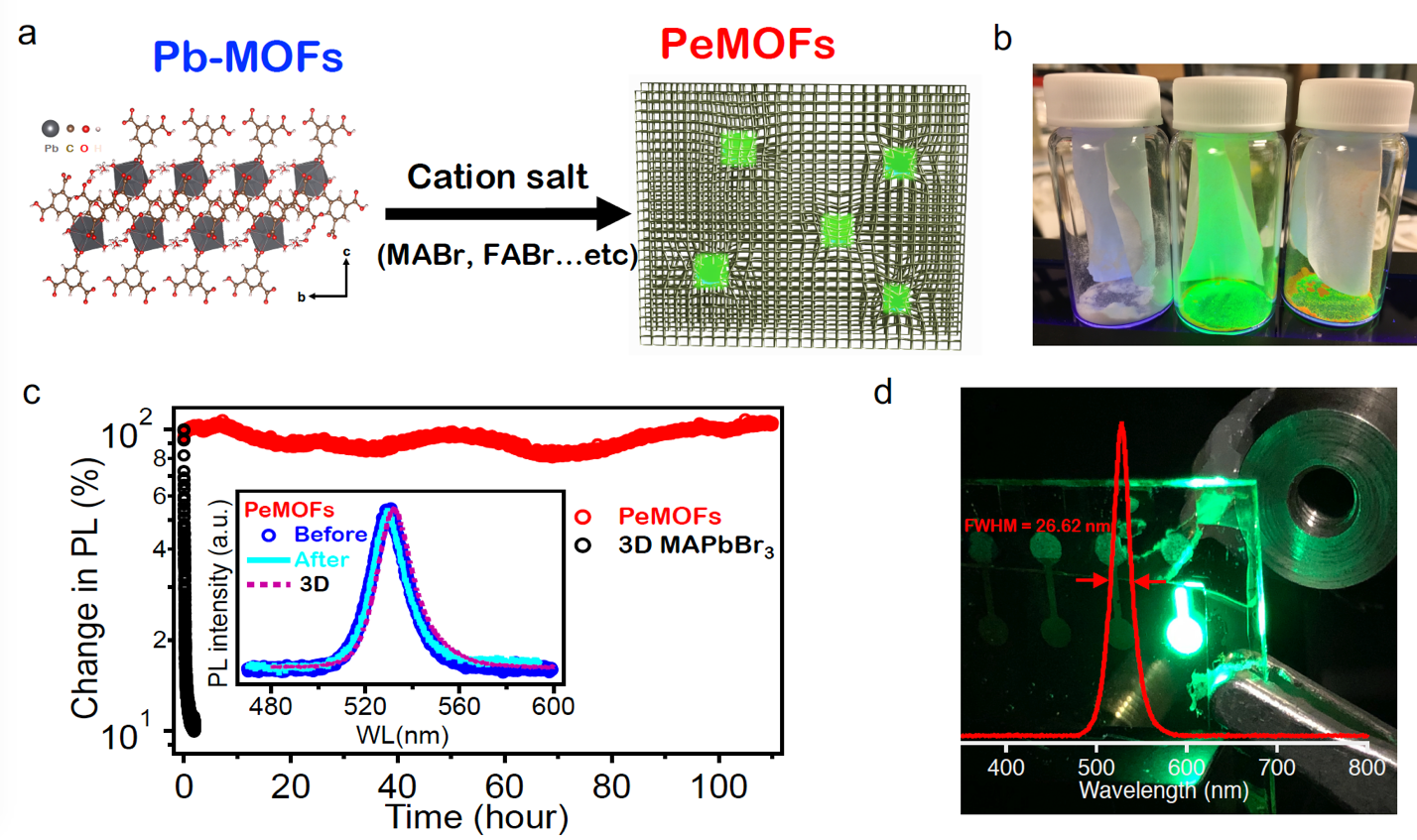
The above diagram shows: a) schematic illustration of the conversion from lead-based MOFs to perovskite-based MOFs; b) from left to right, the pristine Pb-MOF powder, the PeMOF powder after conversion and, for comparison, the bulk-form perovskite powder; c) time evolution of the emission intensity from a PeMOF thin film compared to that from a 3D perovskite thin film illuminated by constant UV lamp; and d) a bright light emitting diode and its electroluminescence spectrum made with PeMOF emission layer.
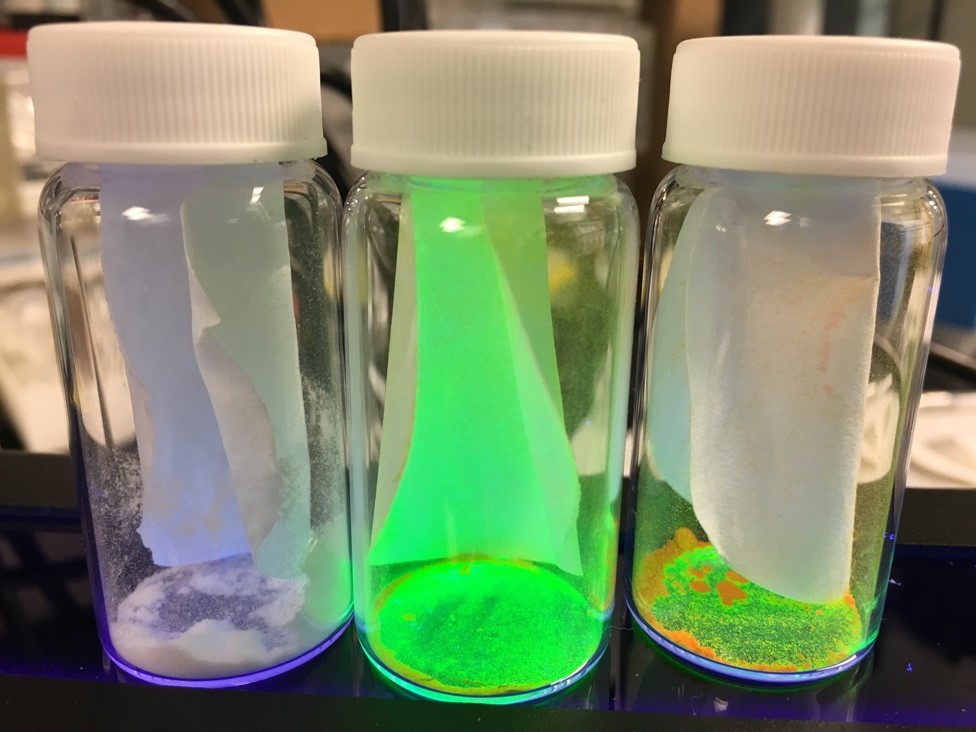
From left to right, the pristine Pb-MOF powder, the PeMOF powder after conversion and, for comparison, the bulk-form perovskite powder.
In research recently published in Nature Photonics, Laboratory researchers and collaborators demonstrate the stabilization of perovskite nanocrystals in a metal-organic framework (MOF). The new nano-structure can synthesize light-emitting diodes (LEDs). The perovskite/MOF materials are solution processable, key to many industrial processes, so the materials can be used for low-cost, large scale, printable electronics, like sensors, display screens for consumer products, and imaging devices such as x-rays.
Metal halide perovskites are unprecedented materials for high efficiency photovoltaics. When made into nano-sizes, the materials are bright light emitters with emission quantum yield approaching unity – the material emits as many photons as it absorbs. Although substantial progress has been made integrating the materials into devices like light emitting diodes (LEDs), and high external quantum efficiency over 20% is achieved, the LEDs suffer from material degradation problems. For instance, nanocrystals can merge to their bulk phase, dimming the light emission yield.
Embedding the perovskite nanocrystal in the MOF matrix potentially mitigates the problem of material degradation. To address that challenge, researchers synthesize a MOF that has lead metal cores linked by large organics forming a three-dimensional network. Then the lead nodes in the MOF are converted to perovskite nanocrystals by introducing organic halide salts. As a result, 10-20 nanometer perovskite nanocrystals form in the MOF matrix. The nanocrystals distribute uniformly in the matrix, and deliver bright green emissions. Because of the protection from the MOF matrix, the perovskite/MOF structure can maintain the emission yield in air over hundreds of hours of UV irradiation without the sign of degradation. High efficiency LEDs are fabricated using the perovskite/MOF nano-material with bright electroluminescence and stable device operational lifetime.
In addition to the ability to LED applications of the perovskite-MOF nano-structure, blue emission can also be achieved. Blue is an essential color needed for display and lighting technologies, yet rarely available with other semiconductors. That capability makes possible a nano-structure with a continuously tunable optical band gap covering almost all the visible spectrum.
Mission and Funding
The work was supported by the Laboratory Directed Research and Development (LDRD) program at Los Alamos National Laboratory and the U.S. Department of Energy, Office of Science, Office of Basic Energy Sciences. The work supports the Energy Security mission area and the Materials for the Future capability pillar.
Reference
“Bright and stable light-emitting diodes made with perovskite nanocrystals stabilized in metal–organic frameworks,” Nature Photonics, 15, 843 (2021). DOI: https://doi.org/10.1038/s41566-021-00857-0. Authors: Hsinhan Tsai, Shreetu Shrestha, Rafael A. Vilá, Wenxiao Huang, Cunming Liu, Cheng-Hung Hou, Hsin-Hsiang Huang, Xiewen Wen, Mingxing Li, Gary Wiederrecht, Yi Cui, Mircea Cotlet, Xiaoyi Zhang, Xuedan Ma and Wanyi Nie
Technical Contact: Wanyi Nie






